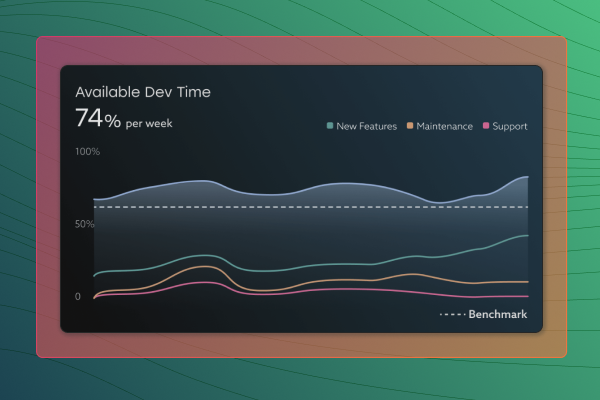In 2019, Microsoft Japan experimented with a four-day workweek. In order to maximize developer focus, they also implemented policies that limited meetings to no more than five people and encouraged all meetings to be no more than 30 minutes (down from 60 as default).
The result? Productivity jumped 40%.
Most employees would focus on the four-day schedule. But what if the real breakthrough was Microsoft's systematic approach to coordination patterns — meeting structures, communication rhythms, and focus protection? Changing how work happens could matter just as much as changing how often work happens.
Engineering leaders invest heavily in better tools, faster infrastructure, and skilled talent. They reduce headcount and tooling when times get tough.
All the while, ways of working — the invisible layer that determines how work actually gets done — remains unexamined.
That's a mistake.
The Invisible Infrastructure of Engineering Work
Ways of working define how engineering teams execute — the collaboration patterns, communication rhythms, and coordination mechanisms that determine whether code ships on time or gets stuck in organizational friction:
-
Rhythms between synchronous and async work
-
Meeting cadences
-
Decision-making processes
-
Focus time allocation and protection mechanisms,
-
Knowledge sharing patterns
-
Work prioritization
-
Handoff processes
-
Team definitions (e.g., what is “ready”, what is “done”)
Most teams never deliberately design these patterns. Standups drift into status updates. Slack channels multiply without purpose. "Quick questions" systematically fragment deep work time.
Over time, these organic patterns create invisible infrastructure that either accelerates or constrains every engineering initiative.
How Poor Coordination Costs Compound
Poor ways of working often remain invisible because they manifest as “just the way it is” slowness rather than obvious failures — a feature, not a bug — until everything grinds to a halt.
But as Microsoft and others have established, coordination patterns determine engineering outcomes more than technical factors.
On one end, teams with effective async communication ship code 2.6x faster than those relying primarily on synchronous coordination. On the other, frequent context switching creates a compound productivity tax. Studies on attention and multitasking show that it can take as long as 23 minutes to refocus after an interruption — destroying efficiency when multiplied across a large engineering org.

Teams can have identical tooling, talent, and technical architecture, yet deliver at dramatically different velocities based purely on how they organize collaborative work:
-
"Always on" culture creates constant interruption pressure that fragments focus time.
-
Reactive prioritization prevents sustained progress on complex work.
-
Tool proliferation worsens the problem — teams juggle Slack, email, Jira, GitHub notifications, and meetings simultaneously, each generating context switches.
Downstream, this manifests as unclear communication, ineffective decision making, knowledge hoarding, and organizational fragility: a textbook of antipatterns when it comes to engineering performance.
Designing Ways of Working Intentionally
The path forward requires recognizing that ways of working aren't inevitable — they can be designed.
High-performing organizations deliberately architect (and re-architect) their collaboration patterns to make efficient, successful delivery predictable. They understand that intentional coordination design becomes a competitive advantage, creating the foundation for every other engineering investment to generate returns.
Four Foundational Engineering Ways of Working
1. Intentional Collaboration Rhythms
Engineering teams face a fundamental tension: coordination requirements versus sustained individual work. Atlassian's data shows 76% of engineers cite excessive meetings as their primary productivity barrier, yet complex software development demands effective collaboration. Not all meetings are bad.
High-performing teams resolve this through deliberate rhythm design:
-
Synchronous time gets allocated to decisions requiring immediate feedback — architecture choices, complex pair programming, and retros building on team input.
-
Asynchronous time handles work benefiting from reflection — thorough code reviews, documentation, and technical research demanding sustained analysis.

A healthy pattern distinguishes between coordination and collaboration. Teams coordinate frequently through structured async communication while collaborating intensively during focused synchronous sessions. This rhythm maximizes both individual productivity and collective decision-making.
2. Collaboration Quality and Team Health
Research from Google's Project Aristotle demonstrates that teams with high psychological safety outperform others regardless of individual talent levels. High-performing teams establish clear decision rights, maintain productive communication channels, and create space for constructive technical disagreement. This translates into practical engineering outcomes: catching design flaws earlier, spending less time in clarification loops, and shipping more reliable code.
Measuring team health through the quality of their collaboration requires both qualitative and quantitative metrics. Collaboration satisfaction scores can be acquired qualitatively in developer sentiment surveys. More quantifiable metrics might track how long teams take to resolve technical choices, or map out knowledge siloes across team members.
Measure Developer Experience Quantitatively

Conversely, the common anti-patterns that sabotage collaboration quality might be meeting-driven development where decisions only happen in scheduled gatherings or hero-driven delivery that concentrates knowledge and decision-making in single individuals.
3. Protected Deep Work Time
The fragmentation of engineering work represents one of the most significant but underrecognized drains on productivity. Developers spend only 30-35% of their time actually coding, with the remainder consumed by meetings, interruptions, and administrative tasks.
Dr. Cal Newport's research on attention residue shows that even brief interruptions degrade performance on subsequent tasks. For complex engineering work requiring sustained cognitive effort, this residue accumulates throughout the day, making afternoon work sessions significantly less productive than morning ones.
Effective leaders create structural support for deep work: time-boxing communication windows rather than maintaining always-on availability, establishing async-first communication norms that reduce immediate response expectations, and designing "focus zones" in both physical and virtual work environments.
4. Clear Decision Rights and Flow
Unclear decision-making creates systemic bottlenecks that compound across engineering work. When teams can’t quickly resolve technical choices, WIP backs up in queues — increasing context switching and degrading delivery predictability.
Consider a team blocked on database schema changes. Without clear authority, the decision bounces between engineering, architecture, and product stakeholders for weeks. Meanwhile, dependent features accumulate in development queues and engineers switch to lower-priority work. The delay cascades through multiple teams and sprint cycles.

Effective organizations establish clear authority distribution that empowers teams while maintaining alignment. This might look like:
-
Creating fast paths for unblocking technical decisions, like mapping decision types to specific roles
-
Establishing escalation processes that engage appropriate stakeholders quickly
-
Designing cross-team coordination mechanisms that minimize dependencies
This clarity reduces cognitive overhead while accelerating delivery. Teams spend less time navigating organizational structure and more time solving technical problems.
Measuring and Improving Collaboration
Traditional metrics like deployment frequency capture outputs, but they miss the collaboration patterns that create those outputs.
Effective measurement focuses on leading indicators: deep work time ratios (high-performing developers average at least 3-4 hours daily vs. < 2 hours for struggling teams), collaboration satisfaction, and decision latency tracking that identifies bottlenecks in technical choices.
Organizations track context switching through calendar analysis, notification patterns, and meeting density assessment. The key insight connects these indicators to engineering outcomes, establishing feedback loops between collaboration patterns and delivery results.
Intentional change through assessment and experimentation
Forward-thinking leaders recognize that strategic ways of working conversations create tremendous value when approached thoughtfully. The key lies in grounding these discussions in solid data, organizational context, and genuine buy-in across all levels.
Systematic improvement begins with baseline assessment of current collaboration patterns — auditing time allocation, communication flows, and decision-making bottlenecks. Teams then experiment with targeted changes, such as protected focus blocks and async-first communication defaults.
This foundation transforms initial small improvements into substantial, lasting results. The Uplevel Method empowers teams through guided introspection and collaborative problem-solving, cultivating the essential skills for continuous improvement and sustained success.
This assessment-experiment-measure framework leverages established change methodologies without operational overhead. Teams identify improvement opportunities, test solutions, and generate data that drives both tactical adjustments and strategic decisions.
Bidirectional information flow helps leadership gains frontline visibility while teams receive strategic context and clear priorities. Continuous feedback cycles produce measurable gains in alignment, velocity, and development environment quality.
The result is organizational change that scales without bureaucracy — teams drive their own improvements while leadership maintains strategic oversight through actionable data rather than process theater.
Ways of Working Enable Literally Everything Else
 Poor collaboration patterns create friction that undermines investments in tools, processes, and talent. But the opposite is also true: Optimized ways of working amplify every other organizational capability.
Poor collaboration patterns create friction that undermines investments in tools, processes, and talent. But the opposite is also true: Optimized ways of working amplify every other organizational capability.
Uplevel's WAVE Framework treats Ways of Working as connected to three other foundational dimensions: Alignment, Velocity, and Environment Efficiency. Effective collaboration improves alignment through better information flow, increases velocity by eliminating systemic delays, and creates efficient development environments through better technical decisions and dependency management.
The OS for Engineering Effectiveness
Engineering is sociotechnical: code quality and velocity emerge from human coordination intersecting with technical capability. Most organizations optimize the technical and leave coordination to chance.
Engineering orgs become significantly more effective when underlying coordination patterns support rather than constrain their potential. The question for engineering leaders is how to approach this systematically — because the organizations that solve ways of working first will find every other improvement becomes exponentially more valuable.
Turn engineering metrics into meaningful change
Learn how Uplevel surfaces collaboration bottlenecks that constrain performance and helps leaders drive sustainable change.


